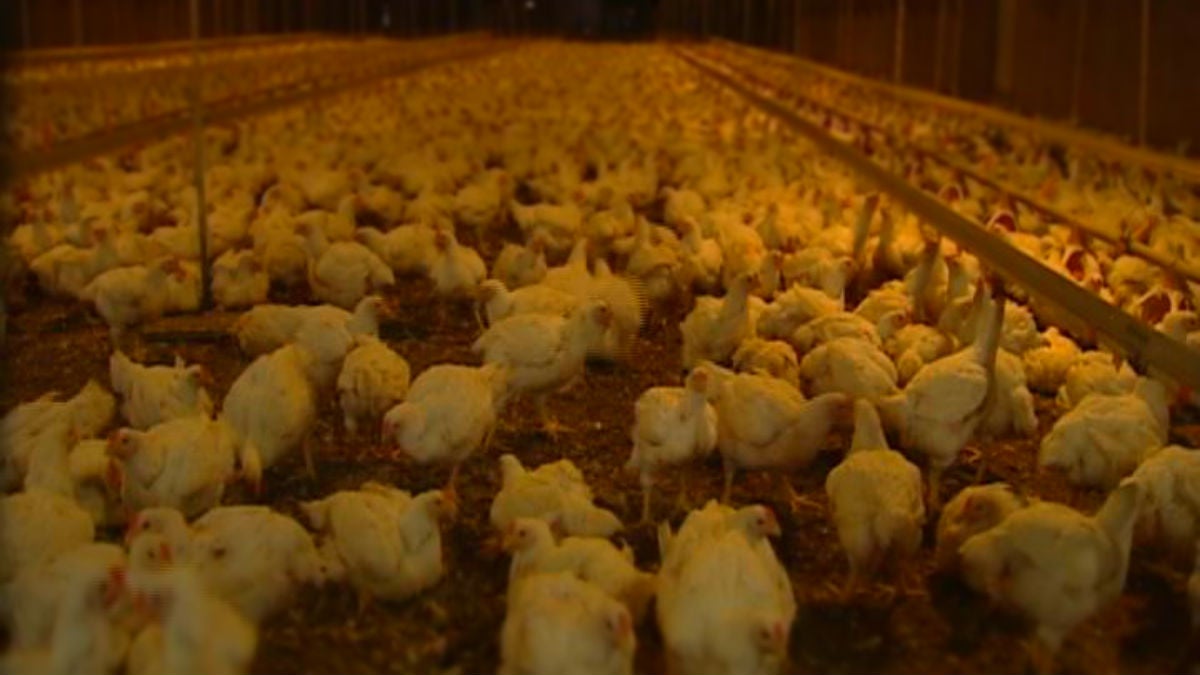Delaware’s growing poultry industry

Chickens outnumber residents in Delaware by more than 200-to-1, and with new chicken houses planned, that ratio could be on the rise.
On a fairly quiet summer afternoon in Farmington, work is underway to transform empty Kent County fields into a home for more than a million chickens. More than 20 chicken houses are planned for a one square mile of land in Kent County.
Delaware’s Agricultural Secretary Ed Kee said two operators have received permits to build a total of 22 chicken houses: 10 at one site and 12 at another adjacent location on Woodyard Road off of Rt. 13.
“Frankly I see this as an anomaly, and it does raise concerns,” Kee said. Those concerns include increased truck traffic in the area and worries about the additional environmental impact from chicken manure.
Bill Satterfield is the executive director of the Delmarva Poultry Industry, Inc. He doesn’t see this heavy concentration of chicken farms on such a small patch of land as the new normal because of the high expense.
“Both of them are unusually large farms. I don’t think we’re going to see that too often, because that’s a very expensive proposition,” Satterfield said. At approximately $400,000 per house, 22 structures would represent an $8 million investment.
200 million birds
Delaware is already home to more than 200 million chickens every year. They constitute a major industry that’s a significant player in Delaware’s economy.
“Delaware chicken goes around the world,” Satterfield said. Most of the exported chicken stays in the U.S., primarily in the northeast and Mid-Atlantic states. About 20 percent is exported overseas.
China is a big consumer of chicken from Delaware, along with nations in the Caribbean and the Middle East. Russia was once a major customer for Delaware chicken, but efforts to establish a poultry industry in Russia has limited exports to that country. Over the years, Russia has banned poultry imports from the U.S.
“Occasionally, Russia will have an issue with our country on something totally unrelated, and they’ll find a good reason to put a quarantine on our poultry,” Kee said. “I’m saying that’s a political thing more than a scientific or real concern.”
Started by accident
The massive industry’s start origins in Delaware was accidental.
Up until the early 1900’s, chickens were primarily raised on farms for their ability to lay eggs, not for their meat. In keeping with that tradition, a woman named Cecilia Steele from Ocean View, Del. ordered 50 chicks for her backyard flock. Due to a miscalculation, the hatchery sent 500.
“She kept them, she raised them,” Kee said. “She sold them 16 weeks later for 63 cents per pound for meat. And the word spread rapidly, and that was the birth of the Delaware and Delmarva poultry industry.”
Since that time, Ocean View is recognized as the birthplace of the broiler chicken industry.
From those humble beginnings, the chicken industry is now controlled by a handful of large “integrators” as they’re called, including Perdue, Tyson and Mountaire.
“It started as a small mom and pop type business to where we are now, producing more than $3 billion worth of product every year on Delmarva,” Satterfield said.
The biggest change was the vertical integration of the industry. The major integrators own the birds throughout their life and contract with local farmers to raise them. With feed and medical care provided by the integrators, the farmer is responsible for making sure the birds grow to the proper weight within a certain period of time, usually seven or eight weeks.
The family farm
Bill Brown is a Delmarva farmer with six chicken houses on his farm in Hurlock, Md.
“We grow for an integrated firm, and we’re a private family farm,” Brown said. He works the farm with his wife MaryLou, their two children and one part-time helper.
Bill Brown spends his days working as the poultry extension agent for the University of Delaware along with growing approximately 150,000 birds on his own farm. He’s always trying to find new ways and better methods of raising chickens.
He’s also fighting against what he believes are common misconceptions the general public has about the poultry industry.
“They typically think of the technology of the 40s or 50s, and you had farmer brown with the pitchfork. You typically had a few hogs and few cattle, and a few chickens in the backyard, and while that is a great image, it’s not reality today.”
While some call massive chicken houses “factory farms,” Brown said they’re just using technological advances to grow more chickens with fewer people.
“Through the adoption of this technology, we’re able to better care for animals today, and it allows one operator to care for large numbers of birds,” he said.
Part of that technology includes fully automated controls for the chicken houses: From lights and fans to temperature and food and water, it’s all run by a central control panel.
Brown is also exploring new light bulbs that drastically reduce energy use, along with using switchgrass to improve the bedding for the chicken houses by trapping the manure produced by birds.
Chicken manure
With so many birds on the Delmarva Peninsula, it’s a big challenge to deal with all the waste produced by the chickens. Satterfield takes issue with anyone referring to chicken litter as waste.
“If you’re referring to chicken manure as a waste, then you are referring to it incorrectly,” he said. “It is a valuable fertilizer product.”
Whatever you call it, finding ways to best use that chicken manure has been a major issue. Much of it gets spread on local farm fields, but over-application has caused runoff that has polluted local waterways, including the Chesapeake Bay.
“Without a doubt, we did over-apply manure prior to the law,” Brown said, referencing the 1999 Nutrient Management Law signed by former Gov. Tom Carper.
“We are sensitive and understand the need to protect those waters,” Kee said. “Every chicken farm has a nutrient management plan that’s with our department and reviewed by not only our department, but our state environmental agency DNREC and the EPA.
The impact of better nutrient management is still working its way through the soil.
“These molecules take a long time to move through the system,” Kee said. “So I think over time, 10 to 20 years, we’ll see the full impact of these practices, and that’s not to say we can’t implement more technologies and even do a better job.”
What’s next
As more chicken houses are installed, what’s the future of Delmarva poultry?
“I think it’s a good future,” Kee said. “I think the industry at all levels is learning how to manage the nutrient issue, and that is very important.”
The industry will likely continue to contribute to other portions of the state’s agriculture economy, which it already dominates.
“It’s an industry that provides a lot of employment, a lot of spillover economic activity,” Satterfield said. “And because our chickens consume locally-grown corn and soybeans, that keeps those farmers in business.”
Industry experts expect the number of farmers growing chickens to decline as efficiencies in the operations allow each operator to grow more chickens on a single farm. Currently, 1500 growers operate more than 4,600 chicken houses on the Delmarva peninsula, which translates to more than 560 million chickens or 3.6 trillion pounds.
WHYY is your source for fact-based, in-depth journalism and information. As a nonprofit organization, we rely on financial support from readers like you. Please give today.





